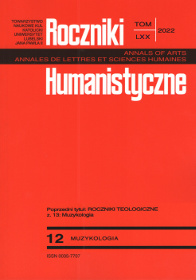Od dhol-tasha do tassa: tradycja i transformacja w indyjskim trynidadzkim bębnie tassa
Abstrakt
Północno-indyjska tradycja gry na bębnach dhol-tasha została rozpowszechniona na całym świecie dzięki brytyjskiemu systemowi umów, który rozpoczął się w latach 30. XIX wieku, kiedy to miliony mężczyzn, kobiet i dzieci zostały wysłane do pracy w rolniczych i przemysłowych koloniach na całym świecie. W wielu miejscach, w których osiedlili się robotnicy kontraktowi, pojawiły się odrębne warianty dhol-tasha. Najbardziej żywym z nich jest bęben tassa w południowo-karaibskim Trynidadzie i Tobago. Utrzymując oczywiste i wymierne związki z indyjskimi przodkami, bęben tassa przeszedł znaczące przemiany w konstrukcji instrumentów, repertuarze i praktyce wykonawczej. Takie innowacje sugerują, że tassa nie jest zwykłym przykładem formą kulturowego przetrwania, ale dynamiczną formą sztuki, opartą na odrębnej indyjskiej estetyce, a jednocześnie całkowicie karaibskiej w swojej diasporycznej kreatywności.
Bibliografia
Averill, Gage. A Day for the Hunter, a Day for the Prey: Popular Music and Power in Haiti. University of Chicago Press, 1997.
Aziz, Ahmed. Studies in Islamic Culture in the Indian Environment. Oxford University Press, 1964.
Ballengee, Christopher L. “From Indian to Indo-Creole: Tassa Drumming, Creolization, and Indo-Caribbean Nationalism in Trinidad and Tobago.” Ph.D. Dissertation, Gainesville, University of Florida, 2013.
Boodhoo, Sarita. “The Bhojpuri Marriage Songs of Mauritius and Their Message.” Fourth International Conference on Oral Tradition and Its Transmission, ed. Edgard Sienaert, Meg Cowper-Lewis, and Nigel Bell, University of Natal, 1994, pp. 130-141.
Dabydeen, David, and Brinsley Samaroo, editors. India in the Caribbean. Hansib, 1987.
Kartomi, Margaret J. Musical Journeys in Sumatra. University of Illinois Press, 2012.
La Guerre, John, editor. Calcutta to Caroni: The East Indians of Trinidad. Longman, 1974.
Manuel, Peter. Tān-Singing, Chutney, and the Making of Indo-Caribbean Culture. Temple University Press, 2000.
Manuel, Peter. Tales, Tunes, and Tassa Drums: Retention and Invention in Indo-Caribbean Music. University of Illinois Press, 2015.
McDaniel, Lorna. The Big Drum Ritual of Carriacou. University Press of Florida, 1998.
“National Inventory: Intangible Cultural Heritage.” Republic of Mauritius Ministry of Arts and Culture National Heritage Fund, 2015.
Niranjana, Tejaswini. Mobilizing India: Women, Music, and Migration between India and Trinidad. Duke University Press, 2006.
Ramnarine, Tina K. Creating Their Own Space: The Development of an Indian-Caribbean Musical Tradition. University of the West Indies Press, 2001.
Sharar, Abdul Halim. Lucknow: The Last Phase of an Oriental Culture. Oxford India Paperbacks, 2012.
Stuempfle, Stephen. The Steelband Movement: The Forging of a National Art in Trinidad and Tobago. University of Pennsylvania Press, 1995.
Vahed, Goolam. “Contesting Indian Islam in KawZulu-Natal: The Muharram Festival in Durban, 2002.” The Popular and the Public: Cultural Debates and Struggles over Public Spaces in Modern India, Africa and Europe, ed. Preben Kaarsholm and Isabel Hofmeyr, Seagull Books, 2009, pp. 109-140.
Wolf, Richard K. “Embodiment and Ambivalence: Emotion in South Asian Muharram Drumming.” Yearbook for Traditional Music 32, 2000, pp. 81-116.
Wolf, Richard K. “Music in Seasonal and Life-Cycle Rituals.” The Garland Encyclopedia of World Music: South Asia, The Indian Subcontinent, vol. 5, ed. Alison Arnold, Garland Publishing, Inc., 2000.
Copyright (c) 2022 Roczniki Humanistyczne

Utwór dostępny jest na licencji Creative Commons Uznanie autorstwa – Użycie niekomercyjne – Bez utworów zależnych 4.0 Międzynarodowe.





